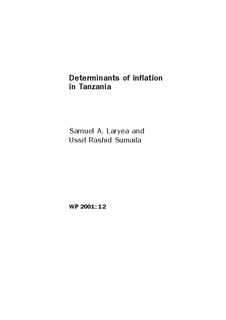| dc.contributor.author | Laryea, Samuel A. | |
| dc.contributor.author | Sumaila, Ussif Rashid | |
| dc.date.accessioned | 2008-02-26T11:40:30Z | |
| dc.date.accessioned | 2017-03-29T09:12:19Z | |
| dc.date.available | 2008-02-26T11:40:30Z | |
| dc.date.available | 2017-03-29T09:12:19Z | |
| dc.date.issued | 2001 | |
| dc.identifier.isbn | 82-90584-96-2 | |
| dc.identifier.issn | 0804-3639 | |
| dc.identifier.uri | http://hdl.handle.net/11250/2435803 | |
| dc.description.abstract | Tanzania’s inflation rate which averaged about 30% in the early 1990’s dropped to about 13% at the end of 1998. Using an error correction model (ECM), this paper estimates an inflation equation for Tanzania based on quarterly data, for the period 1992:1 to 1998:4. The results from the econometric regression analysis shows that inflation in Tanzania, either in the short run or the long run, is influenced more by monetary factors and to a lesser extent by volatility in output or depreciation of the exchange rate. It is recommended that to control inflation in Tanzania, the government should pursue tight monetary and fiscal policies. In the long run, the government should also pursue policies to increase food production to ease some of the supply constraints. | |
| dc.language.iso | eng | |
| dc.publisher | Chr. Michelsen Institute | |
| dc.relation.ispartofseries | CMI Working paper | |
| dc.relation.ispartofseries | WP 2001: 12 | |
| dc.subject | Inflation | |
| dc.subject | Econometric models | |
| dc.subject | Tanzania | |
| dc.subject | JEL classification numbers: E31, E37 | |
| dc.title | Determinants of inflation in Tanzania | |
| dc.type | Working paper | |
